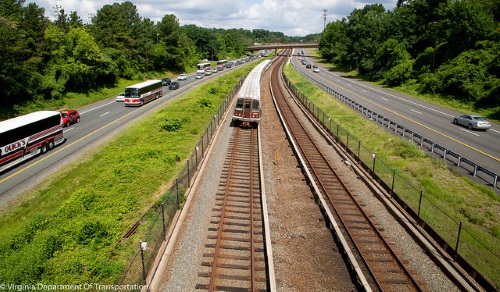Editor’s note: President Trump and Democratic party reached an agreement to re-open the partially shuttered federal government for 3 weeks as of 3 p.m. eastern time on Jan. 25 as they continue to negotiate over immigration issues and funding for a border wall.
Many public transit agencies – especially ones operating in rural areas and relying solely on federal funding – are running out of operating cash and may be forced to curtail or even cancel service if the partial federal government shutdown continues.
[Above photo of Metrorail by VDOT.]
The American Public Transportation Association said it conducted a survey in early January and found 36 percent of public transit agency members indicated that the partial shutdown is “substantially” impacting their operations and/or capital programs.

“This record government shutdown is having critical impacts on public transit systems across the country that are compounding daily,” said APTA president and CEO Paul Skoutelas and APTA Chair David Stackrow in a Jan. 18 letter to Congress. “Agencies report cutting back service, delaying hiring, transferring capital funds to operations, using reserve funds, and other direct impacts. With each passing day, these impacts become worse.”
Due to the shutdown, the Federal Transit Administration is not able to execute grants, cooperative agreements, or contracts, they said – and thus public transportation agencies, which rely on grants to support operations and capital projects, are not receiving any reimbursements for previously approved projects and expended funds.

Ben Fried at the Transit Center noted in a Jan. 23 news story that the FTA disburses a billion dollars a month to fund a wide variety of transportation endeavors, everything from Amtrak to the New York City subway, which normally gets $150 million a month.
“Repairing track, rehabbing buses, buying new buses, expanding rail lines, that’s stuff that the Federal government helps pay for,” Fried added. “And right now there’s no one to sign the checks.”
That doesn’t include revenue lost from decreased ridership, APTA’s Skoutelas and Stackrow said in their letter.

“For instance, the Washington Metropolitan Area Transit Authority estimates that it is losing approximately $400,000 in fare and parking revenue each weekday of the shutdown,” they wrote. “The shutdown could delay certification of state safety oversight programs for states that have not yet received FTA certification, which is required by April 15. Similarly, commuter rail agencies are increasingly concerned that the shutdown could affect implementation of positive train control systems.”
The Bridgeport Transit Authority exemplified how transit is being affected by the shutdown. According to news reports, since the FTA is closed, it did not receive the $3 million federal grant earmarked to fund several projects, including an electric bus pilot program. The agency added that a prolonged shutdown would end up delaying spring construction plans as well.
Rural transit providers are being hit even harder as they rely on federal funding for a large portion of their operating budgets.
For example, according to news reports, rural transit provider OATS Transit – which serves 87 counties in Missouri – relies on 35 percent of its funding from federal grants. And if the shutdown persists to Feb. 4, the agency said it would have to idle four of seven buses operating in one county and make further service cuts – upwards of 25 percent – for 15 counties in mid-Missouri if the shutdown continues past Feb. 4.
Where highway programs are concerned, however, the impact of the shutdown is more mixed.
For example, while the Oklahoma is delaying roughly 45 upcoming highway, county road, and city street projects worth more than $137 million due to the lack of federal funding authorization – a tactic the New Mexico DOT is also using for its January bids, according to news reports – others, such as the Utah DOT and Maryland DOT, are so far planning to continue their current construction bidding plans.



